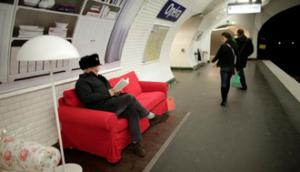
IKEA: The Success Story Behind the Global Furniture Giant
1 May 2023
When it comes to furniture, one name stands out among the rest: IKEA. The Swedish company has become synonymous with affordable, stylish, and functional furniture that has captured the hearts and homes of millions around the world. But how did IKEA become such a successful company? In this article, we’ll delve into the key factors that have contributed to IKEA’s remarkable success.
 Visionary Leadership: Ingvar Kamprad
Visionary Leadership: Ingvar KampradIKEA’s success can be traced back to its visionary founder, Ingvar Kamprad. In the early 1940s, Kamprad started the company at the age of 17, initially selling pens, wallets, and other small items. As the business grew, he recognized the potential in the furniture market and began selling affordable, flat-packed furniture.
Kamprad’s vision was to offer well-designed furniture at prices that were accessible to the masses. He believed that everyone, regardless of their income, should be able to afford stylish and functional furniture. This vision continues to be at the core of IKEA’s philosophy today.
One of the key elements that set IKEA apart from its competitors is its innovative business model of flat-pack furniture. Instead of selling fully assembled furniture, IKEA introduced the concept of selling furniture in flat-pack boxes, which customers could assemble themselves.
This approach allowed IKEA to reduce transportation and storage costs significantly, making their furniture more affordable. It also made it easier for customers to transport the furniture home themselves, eliminating the need for delivery services.
 Stylish and Functional Design
Stylish and Functional DesignIKEA’s success is also attributable to its commitment to stylish and functional design. The company collaborates with renowned designers to create furniture that looks great and maximizes functionality and space efficiency. This focus on design has helped IKEA appeal to a wide range of customers with varying tastes and preferences.
Furthermore, IKEA emphasizes the importance of providing furniture solutions for small spaces. With the increasing trend of urban living and limited living spaces, IKEA’s compact and multi-functional furniture designs have become highly sought after.
IKEA’s democratic design concept is another significant contributor to its success. This concept revolves around offering well-designed, high-quality products at affordable prices. The five key elements of IKEA’s democratic design are form, function, quality, sustainability, and low price.
By integrating these elements into every product, IKEA ensures that customers receive value for their money without compromising on quality or design. This approach has helped IKEA build a strong reputation for delivering affordable products that meet the needs and expectations of its customers.
IKEA’s success is also rooted in its efficient supply chain and cost control measures. The company maintains tight control over its entire supply chain, from sourcing materials to manufacturing and distribution. By optimizing these processes and negotiating favorable terms with suppliers, IKEA can keep costs low without compromising quality.
Additionally, IKEA’s flat-pack concept significantly reduces storage and transportation costs. The company maximizes container space efficiency, minimizing shipping costs and reducing its carbon footprint. These cost-saving measures allow IKEA to pass on the savings to customers, offering affordable prices on its furniture.
 Customer-Centric Approach and In-Store Experience
Customer-Centric Approach and In-Store ExperienceIKEA strongly emphasizes creating a positive and enjoyable in-store experience for customers. IKEA stores are designed as a journey through inspiring room settings, allowing customers to visualize how furniture can be incorporated into their own homes.
Moreover, IKEA’s store layout encourages exploration, with strategically placed displays and interactive areas. The company also offers various services, such as home delivery and assembly assistance, to enhance the customer experience further.
IKEA’s successful global expansion is another key factor in its success. The company has expanded its presence to over 50 countries, adapting its offerings to cater to different markets while maintaining its core values. IKEA understands the importance of localizing its products to meet customers’ specific needs and preferences in each region.
Localization efforts include adapting furniture sizes to fit smaller living spaces in densely populated cities, incorporating local design elements, and considering cultural preferences. By understanding and respecting the local markets, IKEA has been able to build strong connections with customers worldwide.
 Strong Branding and Marketing
Strong Branding and MarketingIKEA’s strong branding and marketing strategies have played a crucial role in its success. The company has cultivated a distinct brand image that represents affordability, quality, and modern design. The iconic blue and yellow logo and its recognizable product names have become synonymous with IKEA.
Furthermore, IKEA’s marketing campaigns focus on showcasing the value and benefits of its products. The company emphasizes its commitment to sustainability, showcasing its efforts to use renewable materials and reduce waste. IKEA also engages customers through social media and interactive digital campaigns, further enhancing its brand presence.
IKEA’s commitment to sustainability has helped the environment and contributed to its success. The company aims to produce affordable, sustainable furniture and has set ambitious goals to become climate positive and circular by 2030.
IKEA invests in renewable energy, sources sustainable materials, and promotes recycling and waste reduction. By aligning its business practices with sustainability principles, IKEA resonates with eco-conscious consumers who appreciate its efforts to positively impact the planet.
IKEA’s success can be attributed to a combination of visionary leadership, an innovative business model, stylish and functional design, a customer-centric approach, efficient cost control measures, global expansion, strong branding, and a commitment to sustainability. The company’s ability to offer affordable, well-designed furniture that meets the needs of a wide range of customers has made it a global furniture giant.
With its ongoing focus on innovation, sustainability, and customer satisfaction, IKEA continues to evolve and maintain its position as a leader in the furniture industry. The company’s success story inspires businesses worldwide, showcasing the power of vision, creativity, and a deep understanding of customer needs.
advertisement

Thank you for signing up!
"*" indicates required fields
advertisement

IKEA: The Success Story Behind the Global Furniture Giant
1 May 2023
When it comes to furniture, one name stands out among the rest: IKEA. The Swedish company has become synonymous with affordable, stylish, and functional furniture that has captured the hearts and homes of millions around the world. But how did IKEA become such a successful company? In this article, we’ll delve into the key factors that have contributed to IKEA’s remarkable success.
 Visionary Leadership: Ingvar Kamprad
Visionary Leadership: Ingvar KampradIKEA’s success can be traced back to its visionary founder, Ingvar Kamprad. In the early 1940s, Kamprad started the company at the age of 17, initially selling pens, wallets, and other small items. As the business grew, he recognized the potential in the furniture market and began selling affordable, flat-packed furniture.
Kamprad’s vision was to offer well-designed furniture at prices that were accessible to the masses. He believed that everyone, regardless of their income, should be able to afford stylish and functional furniture. This vision continues to be at the core of IKEA’s philosophy today.
One of the key elements that set IKEA apart from its competitors is its innovative business model of flat-pack furniture. Instead of selling fully assembled furniture, IKEA introduced the concept of selling furniture in flat-pack boxes, which customers could assemble themselves.
This approach allowed IKEA to reduce transportation and storage costs significantly, making their furniture more affordable. It also made it easier for customers to transport the furniture home themselves, eliminating the need for delivery services.
 Stylish and Functional Design
Stylish and Functional DesignIKEA’s success is also attributable to its commitment to stylish and functional design. The company collaborates with renowned designers to create furniture that looks great and maximizes functionality and space efficiency. This focus on design has helped IKEA appeal to a wide range of customers with varying tastes and preferences.
Furthermore, IKEA emphasizes the importance of providing furniture solutions for small spaces. With the increasing trend of urban living and limited living spaces, IKEA’s compact and multi-functional furniture designs have become highly sought after.
IKEA’s democratic design concept is another significant contributor to its success. This concept revolves around offering well-designed, high-quality products at affordable prices. The five key elements of IKEA’s democratic design are form, function, quality, sustainability, and low price.
By integrating these elements into every product, IKEA ensures that customers receive value for their money without compromising on quality or design. This approach has helped IKEA build a strong reputation for delivering affordable products that meet the needs and expectations of its customers.
IKEA’s success is also rooted in its efficient supply chain and cost control measures. The company maintains tight control over its entire supply chain, from sourcing materials to manufacturing and distribution. By optimizing these processes and negotiating favorable terms with suppliers, IKEA can keep costs low without compromising quality.
Additionally, IKEA’s flat-pack concept significantly reduces storage and transportation costs. The company maximizes container space efficiency, minimizing shipping costs and reducing its carbon footprint. These cost-saving measures allow IKEA to pass on the savings to customers, offering affordable prices on its furniture.
 Customer-Centric Approach and In-Store Experience
Customer-Centric Approach and In-Store ExperienceIKEA strongly emphasizes creating a positive and enjoyable in-store experience for customers. IKEA stores are designed as a journey through inspiring room settings, allowing customers to visualize how furniture can be incorporated into their own homes.
Moreover, IKEA’s store layout encourages exploration, with strategically placed displays and interactive areas. The company also offers various services, such as home delivery and assembly assistance, to enhance the customer experience further.
IKEA’s successful global expansion is another key factor in its success. The company has expanded its presence to over 50 countries, adapting its offerings to cater to different markets while maintaining its core values. IKEA understands the importance of localizing its products to meet customers’ specific needs and preferences in each region.
Localization efforts include adapting furniture sizes to fit smaller living spaces in densely populated cities, incorporating local design elements, and considering cultural preferences. By understanding and respecting the local markets, IKEA has been able to build strong connections with customers worldwide.
 Strong Branding and Marketing
Strong Branding and MarketingIKEA’s strong branding and marketing strategies have played a crucial role in its success. The company has cultivated a distinct brand image that represents affordability, quality, and modern design. The iconic blue and yellow logo and its recognizable product names have become synonymous with IKEA.
Furthermore, IKEA’s marketing campaigns focus on showcasing the value and benefits of its products. The company emphasizes its commitment to sustainability, showcasing its efforts to use renewable materials and reduce waste. IKEA also engages customers through social media and interactive digital campaigns, further enhancing its brand presence.
IKEA’s commitment to sustainability has helped the environment and contributed to its success. The company aims to produce affordable, sustainable furniture and has set ambitious goals to become climate positive and circular by 2030.
IKEA invests in renewable energy, sources sustainable materials, and promotes recycling and waste reduction. By aligning its business practices with sustainability principles, IKEA resonates with eco-conscious consumers who appreciate its efforts to positively impact the planet.
IKEA’s success can be attributed to a combination of visionary leadership, an innovative business model, stylish and functional design, a customer-centric approach, efficient cost control measures, global expansion, strong branding, and a commitment to sustainability. The company’s ability to offer affordable, well-designed furniture that meets the needs of a wide range of customers has made it a global furniture giant.
With its ongoing focus on innovation, sustainability, and customer satisfaction, IKEA continues to evolve and maintain its position as a leader in the furniture industry. The company’s success story inspires businesses worldwide, showcasing the power of vision, creativity, and a deep understanding of customer needs.
Thank you for signing up!
"*" indicates required fields
advertisement
advertisement